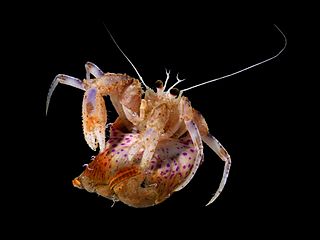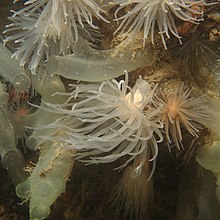
Anthozoa is a class of marine invertebrates which includes the sea anemones, stony corals and soft corals. Adult anthozoans are almost all attached to the seabed, while their larvae can disperse as part of the plankton. The basic unit of the adult is the polyp; this consists of a cylindrical column topped by a disc with a central mouth surrounded by tentacles. Sea anemones are mostly solitary, but the majority of corals are colonial, being formed by the budding of new polyps from an original, founding individual. Colonies are strengthened by calcium carbonate and other materials and take various massive, plate-like, bushy or leafy forms.
Reef safe is a distinction used in the saltwater aquarium hobby to indicate that a fish or invertebrate is safe to add to a reef aquarium. There is no fish that is completely reef safe. Every fish that is commonly listed as reef safe are species that usually do not readily consume small fish or invertebrates. Fish listed as reef safe also do not bother fellow fish unless in some cases, for instance tangs, they do not get along with conspecifics and sometimes fish with similar color or body shape. Every fish has a personality, is different, and, in some cases, are opportunistic feeders. Tangs, which by most accounts are reef safe, may in adulthood eat some crustaceans shortly after they molt. Many larger predatory fish, for instance eels and pufferfish, will adapt very well to a reef tank and will be problem-free as long as they have sizable tank-mates and no crustaceans. Some aquarists have also had success in keeping smaller fish with predatory ones in reef tanks by adding the smaller fish at night, sometimes with newly rearranged rockwork.

Corynactis californica is a brightly colored colonial anthozoan corallimorph. Unlike the Atlantic true sea anemone, Actinia fragacea, that bears the same common name, strawberry anemone, this species is a member of the order Corallimorpharia, and is the only member found in the North American West Coast. Other common names include club-tipped anemone and strawberry corallimorpharian. The anemone can live up to at least 50 meters (160 ft) deep on vertical rock walls, and at the bottom of kelp forests. It is known to carpet the bottom of some areas, like Campbell River in British Columbia, and Monterey Bay in California.

Pachycerianthus fimbriatus is a cerianthid anemone that burrows in substrate and lives in a semi-rigid tube made of felted nematocysts. The anemone is often seen in bright orange to red.

Anemonia sulcata, or Mediterranean snakelocks sea anemone, is a species of sea anemone in the family Actiniidae from the Mediterranean Sea. Whether A. sulcata should be recognized as a synonym of A. viridis remains a matter of dispute.

Aeolidia papillosa, known as the common grey sea slug, is a species of nudibranch in the family Aeolidiidae.

Sea anemones are a group of predatory marine invertebrates constituting the order Actiniaria. Because of their colourful appearance, they are named after the Anemone, a terrestrial flowering plant. Sea anemones are classified in the phylum Cnidaria, class Anthozoa, subclass Hexacorallia. As cnidarians, sea anemones are related to corals, jellyfish, tube-dwelling anemones, and Hydra. Unlike jellyfish, sea anemones do not have a medusa stage in their life cycle.

Stichodactyla helianthus, commonly known as sun anemone, is a sea anemone of the family Stichodactylidae. Helianthus stems from the Greek words ἡλιος, and ἀνθος, meaning flower. S. helianthus is a large, green, sessile, carpet-like sea anemone, from the Caribbean. It lives in shallow areas with mild to strong currents.

Epiactis prolifera, the brooding, proliferating or small green anemone, is a species of marine invertebrate in the family Actiniidae. It is found in the north-eastern Pacific. It has a feature rare among animals in that all individuals start life as females but develop testes later in their lives to become hermaphrodites.

Adamsia palliata is a species of sea anemone in the family Hormathiidae. It is usually found growing on a gastropod shell inhabited by the hermit crab, Pagurus prideaux. The anemone often completely envelops the shell and because of this it is commonly known as the cloak anemone or the hermit-crab anemone.

Haloclavidae is a family of sea anemones. Members of the family are found worldwide and many live largely buried in soft substrates with only their oral disc and tentacles protruding.

Actinodendron arboreum, commonly known as tree anemone or hell's fire anemone, is a species of sea anemone in the family Actinodendronidae. It is native to the Indo-Pacific where it grows at depths of down to 28 metres (92 ft). Most sea anemone species are harmless to humans, but A. arboreum is highly venomous and its sting can cause severe skin ulcers.

Phyllodiscus is a monotypic genus of sea anemones in the family Aliciidae. The only species is Phyllodiscus semoni, commonly known as the night anemone, which is native to shallow seas in the central Indo-West Pacific, such as Indonesia, the Philippines and southern Japan. It is venomous and can cause a painful, long-lasting sting to humans. It is called unbachi-isoginchaku in Japanese which translates as "wasp-sea anemone".

Relicanthus daphneae is a cnidarian which occurs in the depths of the East Pacific Rise and was described in 2006.
Anenthemonae is a suborder of sea anemones in the order Actiniaria. It comprises those sea anemones with atypical arrangement of mesenteries for actiniarians.

Metridioidea is a superfamily of sea anemones in the order Actiniaria. Members of this clade live in shallow subtropical waters worldwide.

In zoology, a mesentery is a membrane inside the body cavity of an animal. The term identifies different structures in different phyla: in vertebrates it is a double fold of the peritoneum enclosing the intestines; in other organisms it forms complete or incomplete partitions of the body cavity, whether that is the coelom or, as in the Anthozoa, the gastrovascular cavity.
Nematosomes are multicellular motile bodies found in the gastrovascular cavity of the model sea anemone Nematostella vectensis starlet sea anemone. First described by Stephenson in 1935, nematosomes are the defining apomorphy (synapomorphy) of the genus Nematostella but have received relatively little study. Nematosomes can be observed circulating through the body cavity and tentacle lumen of adult anemones, occasionally coming to rest on the gastrodermis. Nematosomes that are dislodged from rest return to circulation. The lifespan of a single nematosome has not been studied.

Aiptasia mutabilis, also known as the Trumpet anemone, Rock anemone, and Glass anemone, is a species of anemone typically found attached to substrates in cold waters of the Atlantic Ocean. Its unique trumpet shape gives it its common name and it can grow to be 12 cm, having a column between 3 and 6 cm in size. Like many cnidarians, they rely on nematocysts for protection and to capture prey. They are not difficult to care for, and can be kept in a home aquarium, although due to their speed of reproduction, can quickly become overpopulated.


















